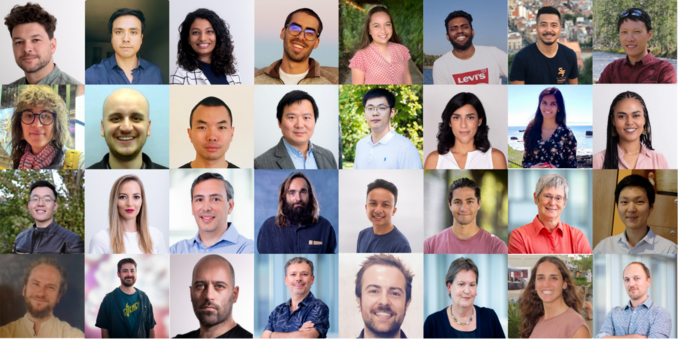Many thanks to the @slschmid_CZB, Joe DeRisi, and @StephenQuake for mentorship in the past 5 years! and to the donors of the @czbiohub for their support.
How do organisms develop from a single cell?
The Royer Lab is a pluridisciplinary team of computer scientists, optical engineers, and biologists. Our goal is to build a time-resolved, multidimensional atlas of vertebrate development using zebrafish as a model organism. To attain this goal, we design, build, and implement novel state-of-the-art light-sheet microscopes, and employ and also design deep learning–based image processing and analysis algorithms.
Plus to our wonderful collaborators, Olivier Pourquie, @Mattia__Serra, @SreejithS_, @haesleinhuepf, @AlexandreDizeux 24/n
All the @czbiohub contributors @mikeborjatweets, Sheryl Paul, Honey Mekonen, Angela Detweiler, @liilii_tweet, Erin McGeever, @Bin_YANG_Optics, @hoover_zhao, @yang_gp, @kyleawayan Samuel D’Souza, @Adrian_Jacobo, @keirballa, Rafael Gómez-Sjöberg, Greg Huber, Norma Neff, @drAOPisco
This work would not have been possible without the amazing #team at @czbiohub sf, in particular, @Merlin_Lange who led this work, and a special shoutout to @ale_agranados, @Shruthi94Vijay, @jobragantini, and @Sarah_E_Ancheta for there wonderful contribution. 22/n
Thanks to last-minute help from @stardazed0 and the admirably twitter-less Jeremy Maitin-Shepard we managed to integrate github.com/google/neuroglancer in zebrahub.org/imaging Check it out! It's amazingly fast! 21/n
We are still trying to understand all this, and have some ideas in the preprint. We expect and hope for a robust and enthusiastic discussion with the community and welcome feedback, ideas, and suggestions! Reach out at merlin.lange@czbiohub.org and loic.royer@czbiohub.org 20/n
To understand the relevant tissue kinematics, we applied the recently developed dynamic morphoskeletons framework from @Mattia__Serra et al. and found that pluripotent NMPs coincide with a strong repeller structure. For more details on the theory check the preprint 😉 19/n
Using the in-vivo experiment we can reconstruct the track of a single pluripotent presumptive NMP! 18/n
'in silico' fate mapping is great, but there is nothing better than a real experiment. Next, we performed similar in vivo photo-manipulation experiments directly in our multi-view light-sheet microscope. Again we find the same fate restriction. 17/n
Using the high-resolution image-based cell tracking together with our @napari_imaging plugin for in silico fate mapping we confirmed the NMP state transition in pluripotency. 16/n
'in silico' fate mapping is great, but there is nothing better than a real experiment. Next, we performed similar in vivo photo-manipulation experiments directly in our multi-view light-sheet microscope. Again we find the same fate restriction. 17/n
Using the high-resolution image-based cell tracking together with our @napari_imaging plugin for in silico fate mapping we confirmed the NMP state transition in pluripotency. 16/n
Going deeper we find that our RNA velocity data and a pseudotime analysis suggest that NMPs are pluripotent (give rise to mesodermal and neural progeny) only during early axis elongation before having their fate restricted to the mesoderm. 15/n
The best part is that you can do such experiments at home too using our @napari_imaging plugin and downloading our data. Check it out here: zebrahub.org/software - we are still ironing out some kinks here and there. Let us know if you face issues! 12/n
We performed 'in silico' fate mapping experiments: we marked cells of interest and followed them over time... With a #digital_embryo, you can do this as many times as you need - which is key to understanding the embryo's incredibly complex multicellular flows. 11/n
In this video, we track a single cell until it divides into two daughter cells that we keep following! We provide the cell tracking data for the timelapse image data. With this data, you have a digital embryo that can be used to do 'virtual experiments'. 10/n
In this video, we track a single cell until it divides into two daughter cells that we keep following! We provide the cell tracking data for the timelapse image data. With this data, you have a digital embryo that can be used to do 'virtual experiments'. 10/n
@jobragantini in the team developed a novel cell tracking algorithm called #ultrack to perform embryo-scale cell #segmentation and #tracking. You can find it here: zebrahub.org/software together with all other software developed or used for this work. 9/n
